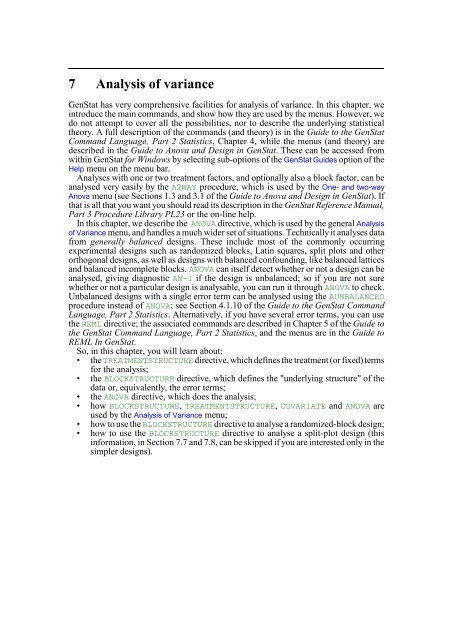Download pdf guide - VSN International
Download pdf guide - VSN International
Download pdf guide - VSN International
- No tags were found...
Create successful ePaper yourself
Turn your PDF publications into a flip-book with our unique Google optimized e-Paper software.
7 Analysis of varianceGenStat has very comprehensive facilities for analysis of variance. In this chapter, weintroduce the main commands, and show how they are used by the menus. However, wedo not attempt to cover all the possibilities, nor to describe the underlying statisticaltheory. A full description of the commands (and theory) is in the Guide to the GenStatCommand Language, Part 2 Statistics, Chapter 4, while the menus (and theory) aredescribed in the Guide to Anova and Design in GenStat. These can be accessed fromwithin GenStat for Windows by selecting sub-options of the GenStat Guides option of theHelp menu on the menu bar.Analyses with one or two treatment factors, and optionally also a block factor, can beanalysed very easily by the A2WAY procedure, which is used by the One- and two-wayAnova menu (see Sections 1.3 and 3.1 of the Guide to Anova and Design in GenStat). Ifthat is all that you want you should read its description in the GenStat Reference Manual,Part 3 Procedure Library PL23 or the on-line help.In this chapter, we describe the ANOVA directive, which is used by the general Analysisof Variance menu, and handles a much wider set of situations. Technically it analyses datafrom generally balanced designs. These include most of the commonly occurringexperimental designs such as randomized blocks, Latin squares, split plots and otherorthogonal designs, as well as designs with balanced confounding, like balanced latticesand balanced incomplete blocks. ANOVA can itself detect whether or not a design can beanalysed, giving diagnostic AN-1 if the design is unbalanced; so if you are not surewhether or not a particular design is analysable, you can run it through ANOVA to check.Unbalanced designs with a single error term can be analysed using the AUNBALANCEDprocedure instead of ANOVA; see Section 4.1.10 of the Guide to the GenStat CommandLanguage, Part 2 Statistics. Alternatively, if you have several error terms, you can usethe REML directive; the associated commands are described in Chapter 5 of the Guide tothe GenStat Command Language, Part 2 Statistics, and the menus are in the Guide toREML In GenStat.So, in this chapter, you will learn about:• the TREATMENTSTRUCTURE directive, which defines the treatment (or fixed) termsfor the analysis;• the BLOCKSTRUCTURE directive, which defines the "underlying structure" of thedata or, equivalently, the error terms;• the ANOVA directive, which does the analysis;• how BLOCKSTRUCTURE, TREATMENTSTRUCTURE, COVARIATE and ANOVA areused by the Analysis of Variance menu;• how to use the BLOCKSTRUCTURE directive to analyse a randomized-block design;• how to use the BLOCKSTRUCTURE directive to analyse a split-plot design (thisinformation, in Section 7.7 and 7.8, can be skipped if you are interested only in thesimpler designs).
















